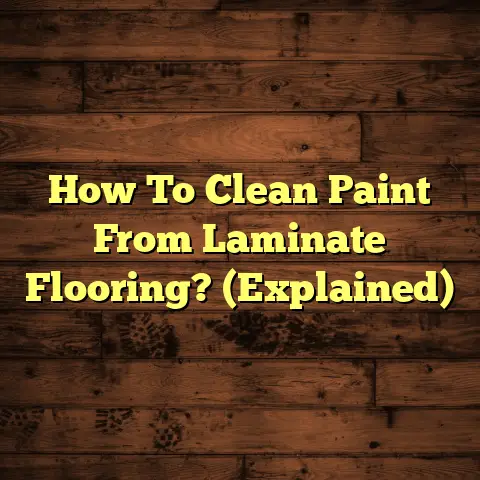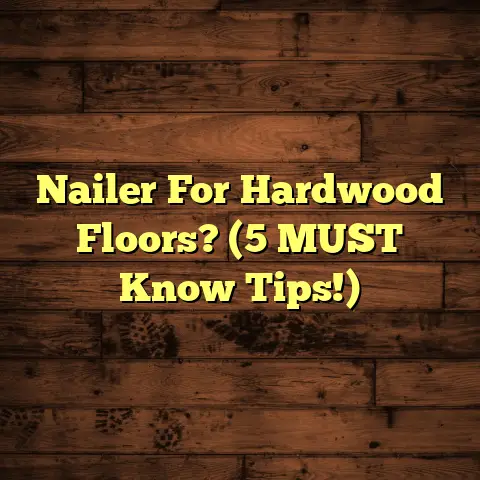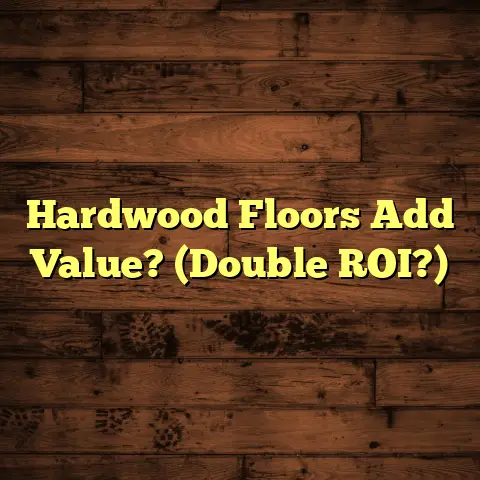Polish Wood Floor Cost? (4-Step Shine Rate!)
Let’s talk about something near and dear to my heart: wood floors.
And more specifically, keeping them looking their absolute best.
Did you know that polished wood floors can increase the value of a home by up to 10%?
That’s right!
It’s not just about aesthetics; it’s an investment.
In this article, I’m going to walk you through everything you need to know about polishing your wood floors, focusing on the costs involved and how you can achieve that perfect shine.
We’ll break down the 4-step shine rate and give you the insider knowledge I’ve gained from years in the flooring business.
So, grab a coffee, settle in, and let’s get started!
Section 1: Understanding the Basics
of Wood Floor Polishing
What is Wood Floor Polishing?
Wood floor polishing is more than just slapping some product on your floors.
It’s a process that enhances the appearance of your wood floors by adding a protective layer and bringing out their natural luster.
Think of it as giving your floors a spa day!
This process typically involves cleaning, applying a polishing compound, and then buffing the floor to achieve the desired level of shine.
It’s a fantastic way to rejuvenate floors that have become dull or scratched over time.
Solid Hardwood vs. Engineered Hardwood
Now, before we dive deeper, it’s crucial to understand the type of wood floor you have.
There are two main types: solid hardwood and engineered hardwood.
-
Solid Hardwood: This is exactly what it sounds like – planks made from a single piece of wood.
It can be sanded and refinished multiple times, making it incredibly durable and long-lasting.
-
Engineered Hardwood: This type consists of a thin layer of real wood (the veneer) bonded to multiple layers of plywood or fiberboard.
While it looks just like solid hardwood, it can only be sanded and refinished a limited number of times, depending on the thickness of the veneer.
Why does this matter for polishing?
Well, the type of wood floor you have will influence the products and techniques you use.
Engineered hardwood, for example, might require a gentler approach to avoid damaging the veneer.
Benefits of Polishing Wood Floors
Why bother polishing your wood floors in the first place?
Here are a few compelling reasons:
-
Aesthetics: Polished wood floors look amazing!
They add warmth, elegance, and a touch of luxury to any room.
A good polish can bring out the natural grain and color of the wood, making your floors a focal point.
-
Protection: The polishing compound acts as a protective layer, shielding your floors from scratches, scuffs, and spills.
This can significantly extend the life of your wood floors.
-
Longevity: Regular polishing can prevent the need for more extensive (and expensive) refinishing.
By maintaining the protective layer, you’re preserving the wood underneath.
-
Ease of Cleaning: Polished floors are easier to clean.
The smooth surface prevents dirt and grime from getting trapped, making your cleaning routine much simpler.
Section 2: Factors Influencing the Cost
of Polish Wood Floors
Alright, let’s get down to brass tacks.
How much is this all going to cost you?
Several factors can influence the price of polishing your wood floors.
Let’s break them down:
Type of Wood
The type of wood you have plays a role in the cost of polishing.
Some woods are more porous and require more product, while others might need special formulations.
Here are a few examples:
-
Oak: A very common and relatively easy-to-polish wood.
It’s durable and takes polish well, making it a cost-effective choice.
-
Maple: This is a harder wood with a tighter grain, which can make it a bit more challenging to polish.
It might require more coats of polish to achieve the desired shine.
-
Cherry: A beautiful, reddish-toned wood that can be more delicate.
It’s prone to scratches, so it needs a gentle approach and high-quality polishing products.
-
Exotic Woods: Woods like Brazilian Cherry (Ipe) or Tigerwood can be tricky.
They often require specialized products and techniques, which can increase the cost.
As a general rule, the rarer or more delicate the wood, the higher the polishing cost.
Condition of the Floor
The condition of your floor is a huge factor in determining the cost.
If your floors are in rough shape, with deep scratches, gouges, or significant wear and tear, they’ll need more prep work before polishing.
This might include:
-
Sanding: Removing the old finish and leveling the surface.
-
Repairing: Filling in cracks and holes.
-
Deep Cleaning: Removing stubborn dirt and grime.
All of this adds time and labor, which translates to higher costs.
On the other hand, if your floors are in relatively good condition, you might be able to get away with a simple cleaning and polishing, saving you some serious cash.
Size of the Area
This one’s pretty straightforward: the larger the area you want to polish, the more it will cost.
Most professionals charge by the square foot, so a large living room will naturally cost more than a small hallway.
Also, larger areas may require more product and more time to complete the job, further impacting the price.
Geographic Location
Where you live can also affect the cost of polishing your wood floors.
Labor costs vary significantly from region to region.
For example, you can expect to pay more for labor in a major metropolitan area like New York City or San Francisco than you would in a smaller town in the Midwest.
Material costs can also fluctuate depending on local availability and transportation costs.
To get a realistic estimate, it’s always a good idea to get quotes from local flooring contractors.
Section 3: Breakdown of Polish Wood
Floor Costs
Okay, let’s break down the actual numbers.
I’ll give you a detailed look at the costs associated with polishing wood floors, whether you’re planning to DIY or hire a professional.
DIY vs. Professional Services
One of the first decisions you’ll need to make is whether to tackle the project yourself or hire a professional.
Here’s a quick comparison:
-
DIY:
- Pros: Lower upfront cost, flexibility to work at your own pace.
-
Cons: Requires time, effort, and some level of skill.
Potential for mistakes that could damage your floors.
-
Professional Services:
- Pros: High-quality results, saves time and effort, professionals have the right equipment and experience.
- Cons: Higher upfront cost, less control over the schedule.
DIY Costs:
For a DIY project, you’ll need to factor in the cost of materials, which we’ll cover in the next section.
You might also need to rent equipment like a floor buffer, which can cost around $50-$100 per day.
Professional Costs:
Professional floor polishers typically charge by the square foot.
The exact rate can vary depending on the factors we discussed earlier, but here’s a general idea:
-
Basic Polishing: $1-$3 per square foot.
-
Polishing with Minor Repairs: $3-$5 per square foot.
-
Polishing with Sanding and Repairs: $5-$10+ per square foot.
So, for a 500 square foot living room, you might pay anywhere from $500 to $5000+ for professional polishing, depending on the condition of your floors and the level of service required.
Material Costs
If you’re going the DIY route, you’ll need to purchase the necessary materials.
Here’s a breakdown of the average costs:
-
Floor Polish: $20-$50 per bottle (covers approximately 500-1000 square feet).
Some popular brands include: * Bona * Rejuvenate * Weiman
-
Cleaning Solution: $10-$20 per bottle.
You’ll want a pH-neutral cleaner specifically designed for wood floors.
-
Applicator Pads: $10-$30 per set.
Microfiber pads are a good choice for applying polish evenly.
-
Buffing Pads: $20-$40 per set.
These come in different grits, depending on the level of shine you want to achieve.
-
Safety Gear: $10-$20 (gloves, mask, eye protection).
Protect yourself from chemicals and dust.
So, for a basic DIY polishing project, you can expect to spend around $70-$160 on materials.
Labor Costs
If you decide to hire a professional, labor costs will make up a significant portion of the overall price.
As I mentioned earlier, most professionals charge by the square foot.
Here are a few things that can affect labor costs:
-
Hourly Rates: Some contractors charge by the hour, which can range from $50-$100 per hour, depending on their experience and location.
-
Additional Services: If your floors need repairs, sanding, or stain removal, these services will add to the labor costs.
-
Complexity of the Job: Intricate patterns or hard-to-reach areas can increase labor time and, therefore, the cost.
Typical Cost Ranges
To give you a clearer picture, here’s a comprehensive overview of typical cost ranges for polishing wood floors:
-
DIY (Basic Polish): $70-$160 for materials.
-
DIY (With Equipment Rental): $120-$260+ (including buffer rental).
-
Professional (Basic Polish): $1-$3 per square foot ($500-$1500 for a 500 square foot area).
-
Professional (Polish with Minor Repairs): $3-$5 per square foot ($1500-$2500 for a 500 square foot area).
-
Professional (Polish with Sanding and Repairs): $5-$10+ per square foot ($2500-$5000+ for a 500 square foot area).
Keep in mind that these are just estimates.
The best way to get an accurate quote is to contact a few local flooring contractors and have them assess your specific situation.
Section 4: The 4-Step Shine Rate
Now, let’s talk about how to achieve that perfect shine.
I’ve developed a 4-step process that I use on all my flooring projects.
Follow these steps, and you’ll be amazed at the results!
Step 1: Preparation
Proper preparation is key to a successful polishing job.
If you skip this step, you’ll end up with a lackluster finish and wasted time and money.
Here’s what you need to do:
-
Clear the Room: Remove all furniture, rugs, and other items from the room.
This will give you plenty of space to work and prevent any accidents.
-
Sweep and Vacuum: Thoroughly sweep and vacuum the floor to remove any loose dirt, dust, and debris.
-
Deep Clean: Use a pH-neutral wood floor cleaner to remove any stubborn dirt and grime.
Follow the manufacturer’s instructions carefully.
-
Repair Damage: Fill in any cracks, holes, or gouges with wood filler.
Let the filler dry completely and then sand it smooth.
-
Sand (If Necessary): If your floors have significant scratches or wear, you might need to sand them down to bare wood.
This is a more involved process that requires special equipment and expertise.
Step 2: Application of Polish
Once your floors are clean and prepped, it’s time to apply the polish.
Here’s how:
-
Choose the Right Polish: Select a high-quality wood floor polish that is specifically designed for your type of wood.
Read the label carefully and follow the manufacturer’s instructions.
-
Apply Evenly: Use an applicator pad or mop to apply a thin, even coat of polish to the floor.
Work in small sections and overlap each stroke slightly to avoid streaks.
-
Let it Dry: Allow the polish to dry completely before moving on to the next step.
The drying time will vary depending on the product and the humidity, but it’s usually around 30-60 minutes.
Step 3: Buffing
Buffing is what really brings out the shine in your wood floors.
Here’s how to do it:
-
Choose the Right Buffing Pad: Select a buffing pad with the appropriate grit for your desired level of shine.
A higher grit will produce a shinier finish.
-
Buff the Floor: Use a floor buffer to buff the floor in a circular motion.
Overlap each pass slightly to ensure even coverage.
-
Repeat (If Necessary): If you want an even shinier finish, you can apply a second coat of polish and repeat the buffing process.
Step 4: Maintenance
Once you’ve achieved that perfect shine, it’s important to maintain it.
Here are a few tips:
-
Regular Cleaning: Sweep or vacuum your floors regularly to remove dirt and debris.
-
Use a pH-Neutral Cleaner: When you mop your floors, use a pH-neutral wood floor cleaner.
Avoid using harsh chemicals or abrasive cleaners, as these can damage the finish.
-
Use Rugs and Mats: Place rugs and mats in high-traffic areas to protect your floors from scratches and wear.
-
Avoid Standing Water: Clean up spills immediately to prevent water damage.
-
Re-Polish as Needed: Depending on the amount of traffic your floors receive, you might need to re-polish them every 6-12 months to maintain the shine.
Section 5: Cost Comparison with Alternatives
So, how does polishing wood floors stack up against other flooring options?
Let’s take a look.
Comparing with Other Flooring Options
-
Laminate: Laminate flooring is typically less expensive than hardwood, but it doesn’t offer the same level of durability or aesthetic appeal.
It can also be difficult to repair if it’s damaged.
-
Tile: Tile is a durable and low-maintenance option, but it can be cold and hard underfoot.
It’s also not as warm and inviting as wood.
-
Carpet: Carpet is soft and comfortable, but it can trap dirt, dust, and allergens.
It also requires regular cleaning and may need to be replaced every few years.
Compared to these options, polished wood floors offer a great balance of beauty, durability, and value.
Long-term Benefits of Wood Polishing
While the upfront cost of polishing wood floors might be higher than some other options, it can actually save you money in the long run.
By maintaining the protective layer, you’re preventing the need for more extensive (and expensive) refinishing or replacement.
Polished wood floors also add value to your home, making them a smart investment.
Conclusion
Alright, we’ve covered a lot of ground in this article.
Let’s recap the main points:
-
Polishing wood floors enhances their appearance, protects them from damage, and extends their lifespan.
-
The cost of polishing wood floors depends on several factors, including the type of wood, the condition of the floor, the size of the area, and your geographic location.
-
You can save money by doing the job yourself, but hiring a professional ensures high-quality results.
-
Following the 4-step shine rate will help you achieve that perfect, long-lasting shine.
Investing in polished wood floors is a great way to add beauty, value, and warmth to your home.
With a little bit of knowledge and effort, you can keep your floors looking their best for years to come.
So, go ahead and give your wood floors the attention they deserve.
You’ll be amazed at the difference it makes!





